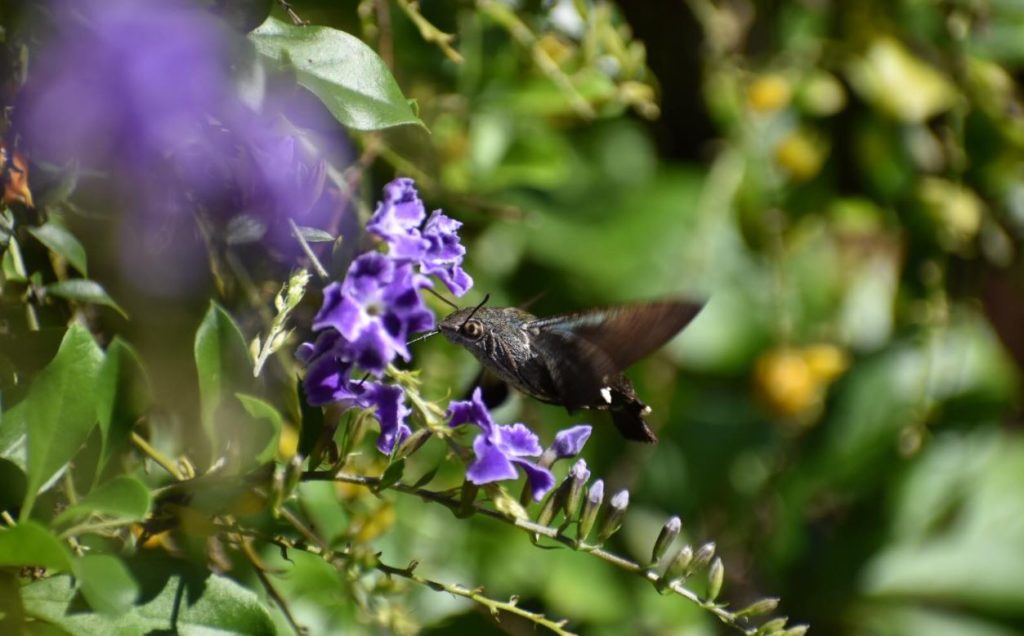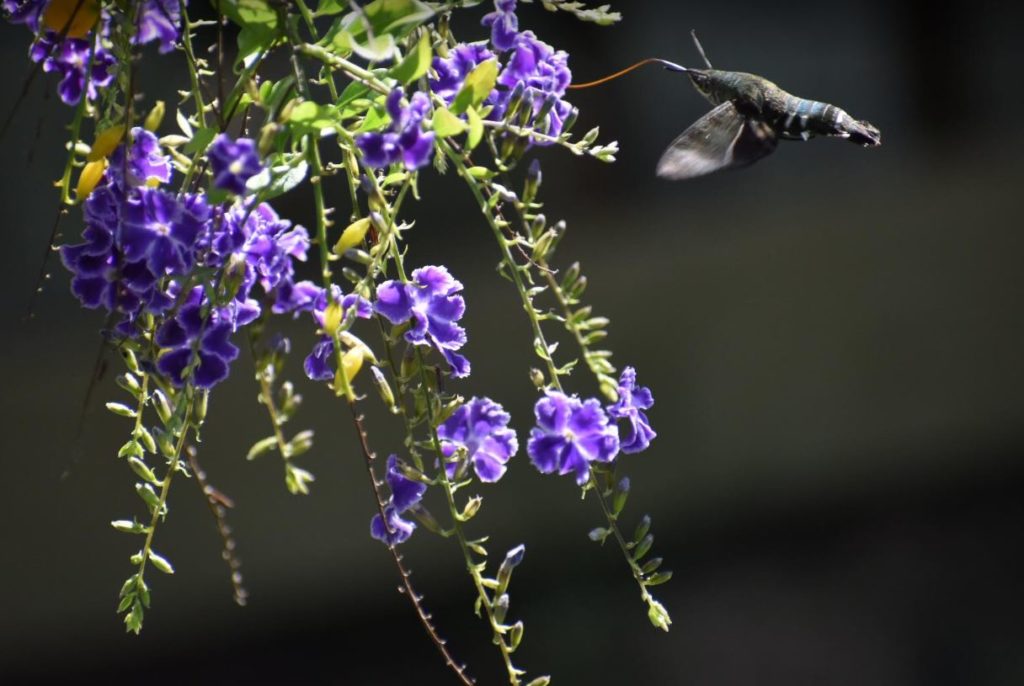
The hummingbird hawkmoth, which looks like a bird but is actually an insect, enjoys some flowers in Brookelyn Sanderson’s garden. Photo: Brookelyn Sanderson
A bird-like insect with fast, flitting movements that you will miss if you blink has been perplexing Bundaberg Region residents over the past few weeks.
The hummingbird hawkmoth has been making a regular appearance in people’s yards, with sharp-eyed nature enthusiasts managing to capture photos of the elusive creature.
Innes Park resident Brookelyn Sanderson was hanging out her washing recently when she said she noticed the creature out of the corner of her eye.
“Because of the butterfly migration I was looking at this tree they like to hang around and I noticed this little thing flitting around,” she said.
“I thought ‘is that a hummingbird? Do we even have hummingbirds in Australia?’ It was moving so quickly.
“I got my camera and about a dozen shots later I managed to get three really good photos.”
Brookelyn said the creature moved very quickly as it darted around the tree.
“I’ve never seen this kind of moth before so I asked my parents if they knew what it was and they didn’t know either,” she said.
“Since my first thought was a hummingbird, I Googled ‘hummingbird moth’.
“I think they are interesting; their body shape and movement make them look so much like a hummingbird.”

Queensland Museum’s Senior Curator of Insects Dr Chris Burwell reviewed Brooklyn’s photos and said the moth was indeed a lookalike of the beautiful hummingbird.
“A hummingbird hawkmoth is a general term for a group of hawkmoths that belong to the genus Macroglossum,” he said.
“Worldwide there are almost 100 different species of hummingbird hawkmoths and Australia and its territories, including Christmas and Cocos (Keeling) Islands, has about 14 species.
“Like most hawkmoths they are quite large with stout bodies.”
Chris said what made hummingbird hawkmoths unusual was they’re active during the daytime rather than at night, like most other hawkmoths and moths in general.
“Four different species of hummingbird hawkmoths can be found in the Bundaberg area,” he said.
“The particular species in the photographs is Macroglossum micacea which doesn’t have a specific common name.
“This species occurs along the east coast of Australia from Torres Strait south to northern New South Wales.”

Chris said the adult moths fed on nectar from flowers using their straw-like proboscis.
“When they aren’t feeding the proboscis is tightly coiled beneath their head,” he said.
“Feeding on nectar from flowers is how most adult moths feed, not just hummingbird hawkmoths.
“The immature stages, the caterpillars of species of Macroglossum, feed on a variety of plants species depending a which particular species they are.”
Chris said while hummingbirds (the bird variety) did not occur in Australia, the moth still suffered a case of stolen identity due to its similar features and movements.
“Firstly they are active during the day, so most people would not think of a moth as a possibility,” he said.
“Secondly, they visit flowers.
“The main source of the confusion is because they hover while feeding on the flowers, very much like a hummingbird.”
Chris said hummingbird hawkmoths were not the only hawkmoths that flew during the day and fed from flowers while hovering.
“Australia has four species of bee hawkmoths (species of Cephonodes) that behave in the same way as hummingbird hawkmoths but can be distinguished by their see-through wings,” he said.
- Other news: Spider Woman identifies redback pretender





Thanks for sharing. I had also noticed this strange creature,…… and also took a few pics,…….along with some pics of butterflies which have been hanging around our back garden, on the same plant, for a few weeks now. Feel free to have a look at the pics on my Facebook page. https://www.facebook.com/rodger.cowell?fref=nf
Interestingly I searched exactly the same words and came up with the same result. It really has been a wonderful time for butterflies. We’ve lived in Bundy for more than 30 years and I’ve never seen so many butterflies.
Regards,
Rodger Cowell.